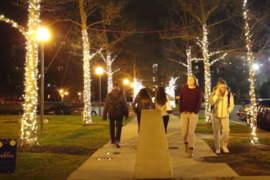On Jan. 19, a group of 20 MIT students crowded around a table lined with supplies in the Eastgate Apartments penthouse. Cylindrical glass vases were placed next to bags of brightly colored stones, and cardboard boxes containing scaly brown bulbs with green pointed tips.
The students were participating in the first event of the “Plants for the People” series, organized by Summer Guest and Conference Housing Coordinator Nelson Feliciano, with support from the MindHandHeart Initiative and the MIT Housing Office. Feliciano conceived of the series as a way to bring greenery and an increased sense of community to campus. He applied for and was awarded a grant to spearhead the project through the MindHandHeart Innovation Fund.
Partnering with the horticulturalist for the Isabella Stewart Gardner Museum, Grace Coburn, Feliciano is planning four additional events this spring. Each event focuses on a different plant and includes a presentation on the biology of the species, a Q&A session, and an interactive demonstration where students select, pot, and tend to a plant to bring home to their residences.
Grace led the first event focused on paperwhites, a fragrant perennial bulb found in tropical areas. “Paperwhites are a great plant for beginners,” Coburn explained. “The bulb carries within it all of the nutrients it needs to grow and it doesn’t require frequent watering.”
Following her lead, the students filled their vases with stones and pushed the paperwhites down into the containers. Within a week of watering, Coburn said, they could expect spindly white roots to appear, followed by green stalks and white flowers. She fielded questions from the group and handed out a care sheet with ongoing instructions.
“Communities can form around caring for plants,” Coburn said. “At events like this, you see people discussing how they cultivate plants in their home, and exchanging tips on what works and what doesn’t. It gives people an opportunity to engage with each other in a supportive, low-stress environment.”
Flora Su, a first-year graduate student who attended the event and brought a spider plant with her to MIT, sees multiple benefits from participating in plant-based activities. “I’m from the environmentally-conscious state of Vermont and majoring in environmental engineering, so maybe I’m biased,” she says. “But being in an urban setting like Cambridge, it often feels like we’re disconnected from the natural world. Taking care of a plant helps to reestablish that connection.”
Su also enjoyed the structure of the event, saying: “Institute-wide activities that get students out of their specific departments are a good way to meet new people and experience more of MIT. Many of us are in very high-pressure academic environments, so events that offer a fun, relaxing break are important for everyone’s sanity.”
According to Feliciano, plants can also play a role in prioritizing self-care. “Caring for a plant in a committed, conscientious way can enrich your life,” he says. “It requires you to pause and consider what this little being needs in order to be healthy. It’s a transferable message that helps students see the importance of nurturing themselves — of eating nutritious food, getting enough sleep, and participating in healthy social activities.”
Next up for Plants for the People, Feliciano and Coburn are planning increasingly challenging and complex demonstrations. Green-thumbed members of the MIT community (and those who aspire to be) can attend an upcoming event to craft a hanging moss ball or graft a cactus.
Considering the long-term impact of the series, Feliciano says: “MIT is a big place and we do our best to make the residence halls welcoming, but sometimes there is an institutional feel to them. Having a bit of green that doesn’t mess up the walls or bother facilities, can make the rooms feel more like home. And it’s a great memento — graduating students can take their plant with them on their next great adventure.”
For more information on the Plants for the People series and upcoming wellness events, visit the MindHandHeart events calendar.
The MindHandHeart Innovation Fund, supporter of Plants for the People, is accepting project applications from March 1-31. MIT students, faculty, and staff members are encouraged to submit ideas to make MIT a healthier, stronger, or more welcoming place.
MIT students, faculty, and staff members can visit the Isabella Stewart Gardner Museum for free with an MIT or Lincoln Lab ID card. Visit Arts at MIT for more information.
















